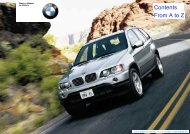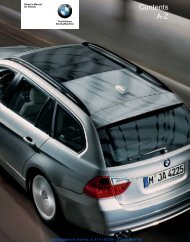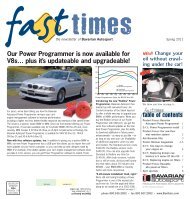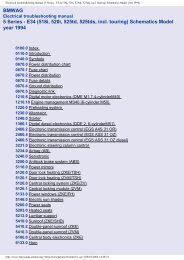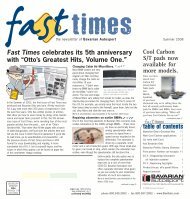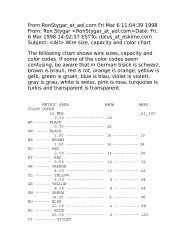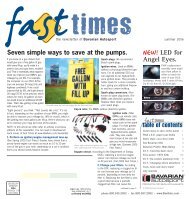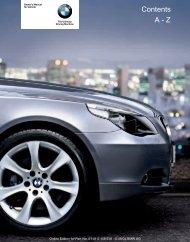Online Edition for Part no. 01 41 2 604 027 - © 03/10 BMW AG
Online Edition for Part no. 01 41 2 604 027 - © 03/10 BMW AG
Online Edition for Part no. 01 41 2 604 027 - © 03/10 BMW AG
Create successful ePaper yourself
Turn your PDF publications into a flip-book with our unique Google optimized e-Paper software.
Driving<br />
For your safety<br />
Automatic Hold is automatically deactivated<br />
when:<br />
> The engine is switched off<br />
> The driver's door is open and the safety belt<br />
of the driver is disconnected<br />
> The vehicle is braked to a stop during driving<br />
In the instrument panel, the indicator<br />
lamp changes from green to red and<br />
the indication AUTO H goes out.<br />
Indicator lamp on Canadian models.<br />
Releasing<br />
1. Open the left-hand side panel in the cargo<br />
area.<br />
2. Remove the first-aid kit* and warning triangle*<br />
if necessary. Close the bracket of the<br />
warning triangle.<br />
3. Insert the releasing tool, contained in the<br />
onboard tool kit under the floor panel, refer<br />
to page 262, at the releasing point.<br />
Be<strong>for</strong>e you start to drive, either release the<br />
parking brake manually, refer to page 60, or<br />
reactivate Automatic Hold, refer to page 61.<br />
Be<strong>for</strong>e leaving the vehicle with the engine<br />
running, shift the selector lever into position<br />
P of the automatic transmission and make<br />
sure that the parking brake is set. Otherwise,<br />
the vehicle may begin to roll.<<br />
Malfunction<br />
If the parking brake fails or malfunctions, secure<br />
the vehicle against rolling, e.g. with a wheel<br />
chock, if you leave the vehicle.<br />
Releasing parking brake manually<br />
In the event of an electrical power loss or electrical<br />
malfunction, you can release the parking<br />
brake manually.<br />
Be<strong>for</strong>e manually releasing the parking<br />
brake and each time you park the vehicle<br />
without setting the parking brake, make sure<br />
that the automatic transmission is in position P,<br />
refer to page 64. Be sure to pay attention to the<br />
in<strong>for</strong>mation in the instrument panel.<br />
In addition, secure the vehicle against rolling,<br />
e.g. with a wheel chock. Otherwise there is a<br />
danger that the vehicle could roll if parked on a<br />
steep slope.<<br />
Jump starting and towing, refer to in<strong>for</strong>mation<br />
starting on page 274.<br />
4. Firmly pull the releasing tool upward against<br />
the mechanical resistance, refer to arrow,<br />
until a considerable increase in <strong>for</strong>ce is felt<br />
and the parking brake is then clearly heard<br />
to release.<br />
5. Stow the releasing tool, warning triangle*<br />
and first-aid kit* and close the left side<br />
panel in the cargo area.<br />
Only have a malfunction corrected by the<br />
nearest <strong>BMW</strong> Sports Activity Vehicle<br />
Center or a workshop that works in accordance<br />
with <strong>BMW</strong> guidelines and uses appropriately<br />
trained personnel. If the parking brake has been<br />
released manually in response to a malfunction,<br />
only technicians can return it to operation.<<br />
Following manual release, the actual status<br />
of the parking brake may deviate from<br />
that displayed by the indicator lamp.<<br />
Operation after interruptions in power<br />
supply<br />
The parking brake can only be used again<br />
if it was manually released due to an interruption<br />
in the supply of electrical power. Otherwise<br />
the operation of the parking brake is <strong>no</strong>t<br />
ensured and there is a danger of the vehicle rolling<br />
despite the parking brake being set.<<br />
62



